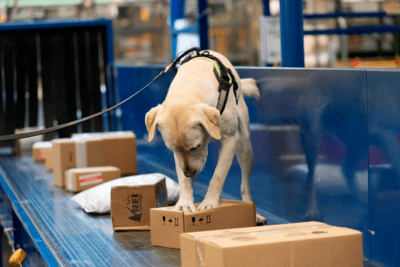THE Department of Agriculture says a reduction in detector dog numbers over the past seven years, as revealed by the Inspector General of Biosecurity report in May, does not equate to a loss in Australia’s biosecurity protection standards.
 The report revealed detector dog numbers have dropped from 80 in 2012 to 36 in 2019. It also concluded that detector dogs were the most effective method of detecting undeclared meat products at Australi’s borders. The report recommended the Government prioritise investment in increasing the number and use of detector dogs.
The report revealed detector dog numbers have dropped from 80 in 2012 to 36 in 2019. It also concluded that detector dogs were the most effective method of detecting undeclared meat products at Australi’s borders. The report recommended the Government prioritise investment in increasing the number and use of detector dogs.
In response to Beef Central’s questions about the reduction in biosecurity detector dog numbers operating at Australian airports over the past seven years, the Department said it has moved to a risk-based approach in managing risks at Australia’s border.
“This shift has been guided by science, intelligence and data,” a written statement from the Department said.
“Biosecurity resources are targeted to the pathways that present the highest biosecurity risk while maintaining assurance on lower risk items and pathways.
“Since 2012, the department has improved detector dog capability through the implementation of multi-purpose detector dogs—this means that detector dogs are trained to be deployed across multiple biosecurity risk pathways including across the traveller, mail and cargo pathways.
“Prior to 2012, detector dogs were confined to working within the one biosecurity risk pathway only.
“Implementation of multi-purpose detector dog capability has enabled the department to more effectively utilise the detector dog fleet and allowed a natural decline in our fleet over the past 7 years.
“The department is also investing in new screening technology, such as 3D x-ray with automated detection capabilities. This advanced detection technology is being used to detect fruit and vegetables and will shortly be expanded to detect other significant threats such as seeds and meat.
“These advancements are a world first in biosecurity and are being utilised alongside other measures that are in place to manage the emergence of new biosecurity risks, including our detector dog fleet.
“Heightened intervention introduced for travellers and mail from high risk destinations for African Swine Fever includes the use of detector dogs.”

In writing her report, Helen Scott-Orr was fully aware of the Department’s “risk-based approach” but still made a point of reporting her concerns at the reduction in detector-dog numbers and staffing at the borders.
Question: Have detector dogs ever been used for tick detection?